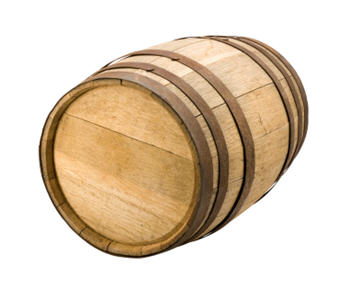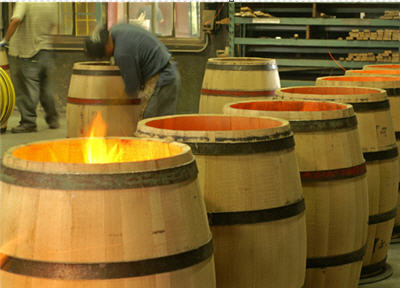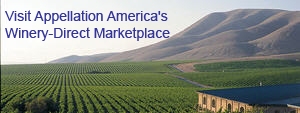

THE ART AND SCIENCE OF BARREL MAKING
The Terroir of Wine Barrels
by
Rhoda Stewart
July 31, 2009
 he evolution to 60-gallon oak barrels for red wine ageing in the U.S. has accelerated in the past 30 years. Following Repeal of Prohibition in 1933, winemakers in California resumed the traditional practice of ageing their wines in redwood tanks. A few invested in large oak casks or ovals for their best wines. Ageing wines in small oak barrels, already an established practice for decades in Europe, was a revolutionary concept in California during the 1940s, ‘50s, and ‘60s that only a few top producers at that time embraced.
he evolution to 60-gallon oak barrels for red wine ageing in the U.S. has accelerated in the past 30 years. Following Repeal of Prohibition in 1933, winemakers in California resumed the traditional practice of ageing their wines in redwood tanks. A few invested in large oak casks or ovals for their best wines. Ageing wines in small oak barrels, already an established practice for decades in Europe, was a revolutionary concept in California during the 1940s, ‘50s, and ‘60s that only a few top producers at that time embraced.
Ridge Vineyards, Cupertino, established in 1962, was among the first wineries to age its wines (both Cabernet and Zinfandel) in small oak barrels. “Using small barrels for the flavors and character that they could add to red wines was a revolutionary concept in California winemaking,” said Paul Draper, Ridge’s winemaker since the early 1970s. Ridge’s choice was American oak from Arkansas. Draper personally selected his staves from wood that had been given a few months’ air-drying before going into the kilns, and oversaw the traditional gas-fire charring, rejecting any barrels that did not meet his standards.
By the 1970s, increasing numbers of producers not only understood that if you wanted to make world class wines, you aged them in 60-gallon oak barrels, but also that those barrels should be of French oak. Lesser wines, which for many producers included Zinfandel, were aged in barrels that had been coopered from kiln-dried and gas-fire charred American oak intended primarily for bourbon ageing. “Those barrels were fine for whiskey,” said Mark Heinemann, General Sales Manager for Demptos Napa Cooperage since 1990, “but if you’re looking for delicacy and sweetness, a bourbon barrel cannot supply that.”
What factors should a winemaker consider when selecting of oak barrels for ageing their wines?
Jason Stout, International Sales Director with Cooperages 1912 (the wine barrel sales division representing the brands World Cooperage and T. W. Boswell), identifies four factors, but only after the winemaker has determined the style of wine best suited to the fruit and vineyards he or she is working with. The style, said Stout, has to be the first consideration because that partly determines whether the choice would be American or French (or perhaps other European-grown) oak. “It’s not fair to say out of hand ‘I like only French oak,’ or ‘I like only American oak.’”
1: The species/forest of oak; the length of time for seasoning (air-drying) of the staves; the grain of the staves; and the toasting time and temperature. 2: The species selection takes into account the forest and regional impact on the trees.
Seasoning (air-drying) is necessary to break down the wood through months of exposure to the seasonal elements and to the micro-flora and molds that are

Fire toasting the barrel wood at Demptos Napa Cooperage.
3: To maintain consistency of grain, Cooperages 1912 sorts staves at the mill site by grain, preferring, for the most part, the finer grained selections. “Fine grain is our standard,” said Stout. Medium- to coarse- grained barrels are made upon request.
4: Toasting with attention to how long and at what temperatures, said Stout, is the final stage in creating a barrel that will enhance the style of wine it is being prepared for.
To assist winemakers in selecting the right toasting option for their barrels, World Cooperage offers “barrel profiling” on its website: www.worldcooperage.com.
The Importance Of Grain
Mark Heinemann, Demptos Cooperage Napa, whose passion for all aspects of oak barrel manufacturing seems to radiate from every fiber of his being, considers grain of the staves and how they are seasoned as the two most important factors in barrel selection.“Grain is important for consistency of extracts and oxidation rates,” he said. For its French oak barrels, Demptos makes its tree selections in terms of three

The barrel staves in the process of being fire bended.
“One thing we at Demptos believe is that tighter grain is not automatically better, since the question arises, ‘Better for what?’ For your richest and most concentrated Cabernet Sauvignon from hillsides, yes. Tight grain oak like Tronçais allows for higher oxidation, but much lower extraction. If you’re using 8-Tons/acre Cab from the valley floor, however, the wine will not have the same richness and concentration, so you will you need something to fill out the center. A barrel from wider grain selection, 5 – 8 grains/inch such as we get from Vosges or Limousin, can help build the middle body. The aromatic contribution is lower in wide grain wood, and it is less oxidatative than tight grain. But it is very extractive.”
“Consistency of flavor and of the oxidation and extract rates are the factors that directly affect wines,” said Heinemann, “and are determined more by grain than by forest, whether the oak is from France, Hungary, or the US.”
The same principles apply to the selection of barrels for fermentation of Chardonnay and Sauvignon Blanc. Heinemann does acknowledge that the ground the tree grows in makes a difference. A tree is a living organism, and grain can vary within a forest. That’s why Demptos, like most cooperages, selects trees within a range of grains per inch per forest.
The Importance of Seasoning
Heinemann also reiterates the importance of how long and where the stave wood has been seasoned. “The importance of where the wood is air-dried cannot be over-emphasized,” he said. “In this way, one controls the micro-flora molds that grow on the wood in that area. To the extent that the region has had similar rainfall and similar humidity during the heat of summer year to year, you know what molds are propagating and what is the direct effect of those molds on the polysaccharides (unfermentable sugar) developing in the stave wood.“Mold is a requirement for premier barrels,” added Heinemann. “It is needed for sweetness, for supplying the tiny per










 READER FEEDBACK: To post your comments on this story,
READER FEEDBACK: To post your comments on this story,





